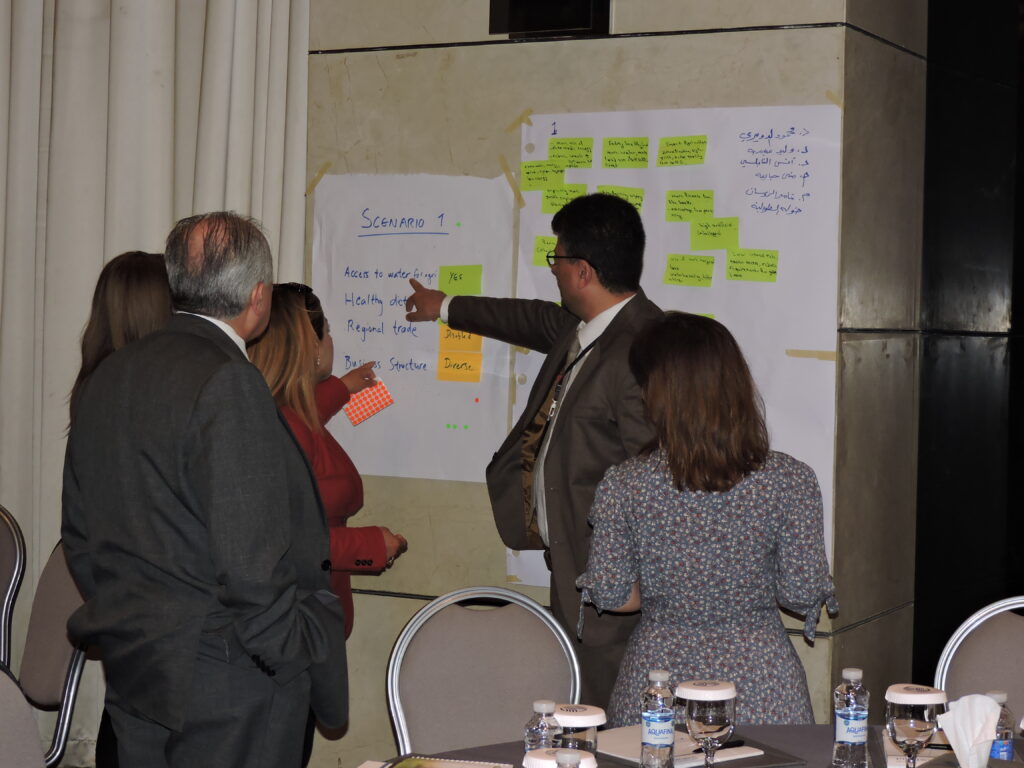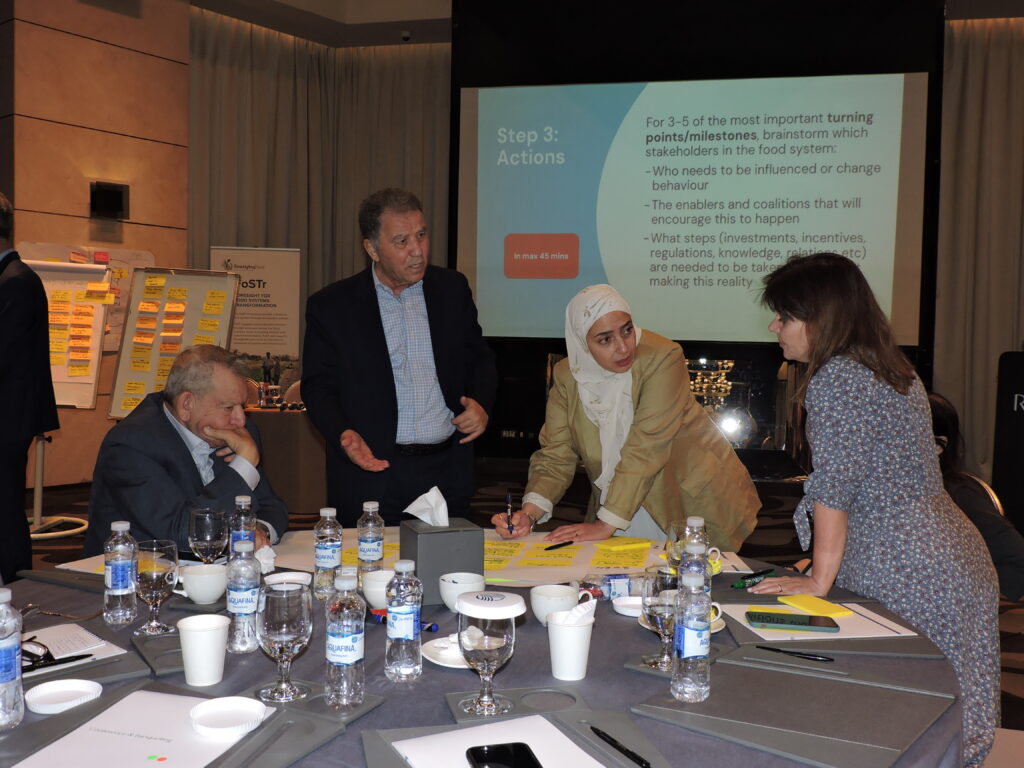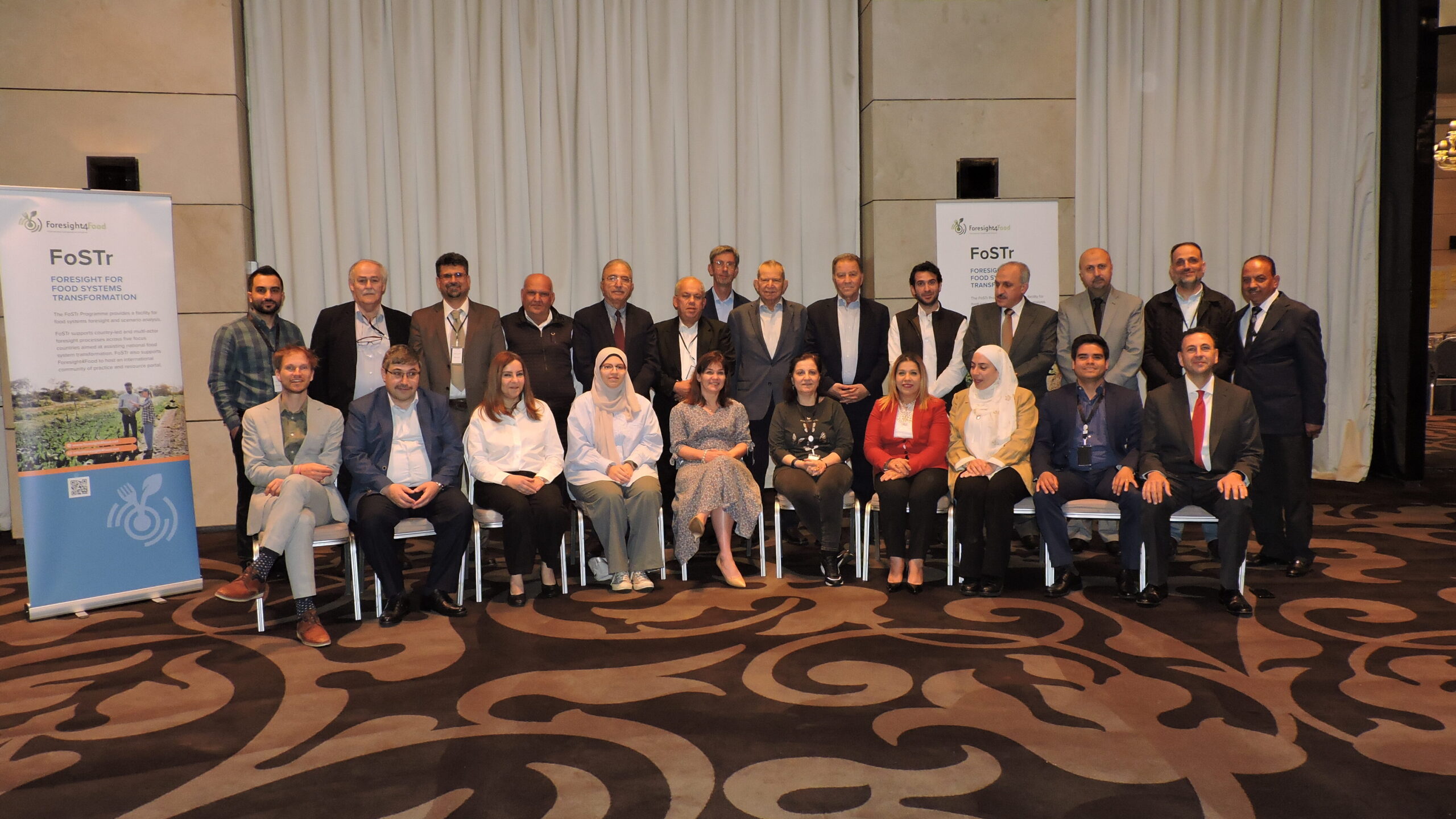by Bram Peters
As a part of the FoSTr programme, the Foresight4Food team organized the “Exploring Alternative Futures for Jordan’s Food System” workshop in Amman, Jordan that brought together food systems stakeholders in Amman to discuss the future of Jordan’s food security. Here are some of the observations and insights from the event.
With themes of resilience, adaptation, action, and collaboration, participants engaged in scenario planning and back-casting exercises to anticipate challenges and shape future outcomes. Key uncertainties like water availability, healthy diets, regional trade, and business structures were explored through four scenarios set in 2040. These insights, supported by quantitative modeling, fostered rich discussions about desirable futures and the actions needed today to create a sustainable, resilient food system for Jordan.
During the workshop, colleagues from the University of Jordan and Jordan University of Science and Technology presented four policy briefs. These were: Food Loss and Waste, Water-to-Food Conversion, State of Smallholder Farming in Jordan and Malnutrition. Each policy brief captures the state of knowledge and offers recommendations to explore how to address these issues from a food systems perspective.
The FoSTr team introduced four critical uncertainties that will be highly important and uncertain to the long-term future of the Jordan food system:
- The extent of fresh water available to agriculture
- The extent to which healthy diets are adopted
- Level of ease of regional trade
- The type of business structure the food system will have
Each of these uncertainties was combined to offer four scenarios, taking place in 2040, up for discussion with the participants. Supported by insights from quantitative simulation modelling, the implications on food systems outcomes were explored in each scenario. Some scenarios described that the people of Jordan adopt healthy diets despite a challenging regional trade situation. In others, severe limitations on fresh water for agriculture were seen in combination with a highly corporate-led food system.



Additionally, the participants explored how that situation might look in each. These scenarios served to open up minds towards the possibility of different situations emerging in the future and highlight the need for anticipatory action and systemic change.
The scenarios led to a discussion of what might be the ‘most likely‘ and ‘most desirable’ scenarios for the Jordan food systems stakeholders. The outline of a desirable future, informed by trends and uncertainties, was formulated to serve as a guiding star. A back-casting approach was used to then explore what events and turning points might occur between 2040 and now to realise that desired future. Based on this timeline, stakeholders brainstormed a range of different actions and stakeholders which are needed now, to already start pushing the system towards the Desired Future.
Building on the encouraging shared co-ownership of the results of the workshop, the Foresight4Food FoSTr team will continue efforts to develop policy briefs, deepen the action areas that were developed, and support the Food Security Council of Jordan in proving the underpinnings for the ongoing work on national food systems transformation.

By Just Dengerink
Foresight training for Africa Foresight Academy by Foresight4Food researchers and Wageningen University & Research (WUR)
The Foresight4Food initiative aims to connect and inspire networks of foresight professionals around the world. In early July 2022, members of the Africa Foresight Academy participated in a foresight training at Oxford, provided by Foresight4Food researchers from the University of Oxford’s Environmental Change Institute (ECI) in collaboration with Wageningen University & Research (WUR). The training was attended by five African researchers in person, while five others joined in online.

The Foresight4Food ‘seven steps’ approach to scenario and foresight analysis (see illustration below) was used to develop four scenarios for a more climate-resilient Ghana in 2040. Here’s a look at how these scenarios were developed using the Foresight4Food approach in the training session.

Scoping the process and mapping the food system
The scenario exercise started with scoping and delineating the focus of the scenario process Collectively, it was decided to focus the scenarios on the future of the Ghana food system in 2040, and the resilience of this system to external shocks related to climate change.
Participants were invited to draw a ‘rich picture’ of the Ghana food system to map out its most important features. These included small-scale yam and cocoa production in the south, maize and sorghum production in the north, fisheries along the coast and around Lake Volta along with the role of urban informal food markets, the lack of a large food processing sector, Covid-19’s impact on supply chains, growing security threats in the region, and the effect of the war in Ukraine on fuel prices and availability of fertilizers.

From assessing trends and uncertainties to constructing scenarios
Building upon the key features of the Ghana food system from the ‘rich picture’ exercise, participants were then invited to identify the most important trends and uncertainties affecting the Ghana food system.
Highlighted key trends included fast population growth and urbanization, increasing use of technology, growing dependence on food imports and remittances, decreasing occurrence of crop diseases, growing youth unemployment, and the increase in fast food consumption.
Together, the participants also identified some important uncertainties regarding the future of the Ghana food system: the degree of extreme weather events, the implementation efficiency of climate resilience policies, and the vulnerability of households to climate change. Other uncertainties identified included future access to fertilizers, fluctuations in fuel prices, changes in trade regimes, levels of agricultural productivity, the expected value of the Ghanaian currency, the potential influence of future Covid outbreaks and the impact of developments in the general security of the region.
The participants then decided on two key uncertainties that would be critical in determining the future climate resilience of the Ghanaian food system. Based on these two key uncertainties, a matrix was created with each of the axes representing one uncertainty. Within this matrix, four scenarios were constructed, based on their position on both axes and with input from the other uncertainties that were identified.

Assessing implications, exploring system changes and designing pathways
With the four scenarios in place, participants were invited to give more colour to these four plausible futures by exploring the implications of each scenario for different stakeholder groups. One group explored the implications for rural farmers, while the other focused on urban consumers.
With the implications of each scenario explored in more detail, participants were asked to zoom out and think about the possible system changes that – in each scenario – could contribute to a more climate-resilient future of the Ghanaian food system. Suggestions included the stimulation of climate-smart agriculture practices, diversification of production and dietary patterns, strengthening regional trade, supporting home gardens and peri-urban agriculture and digitalization of supply chain management.
This three-day exercise with African foresight experts showed how the Foresight4Food approach can help structure a participatory foresight process that leads to engaging scenarios and actionable policy recommendations to shape the future of our food systems.